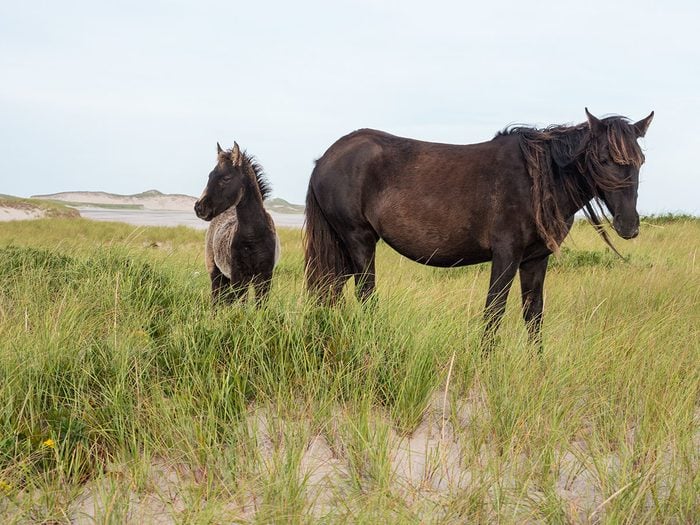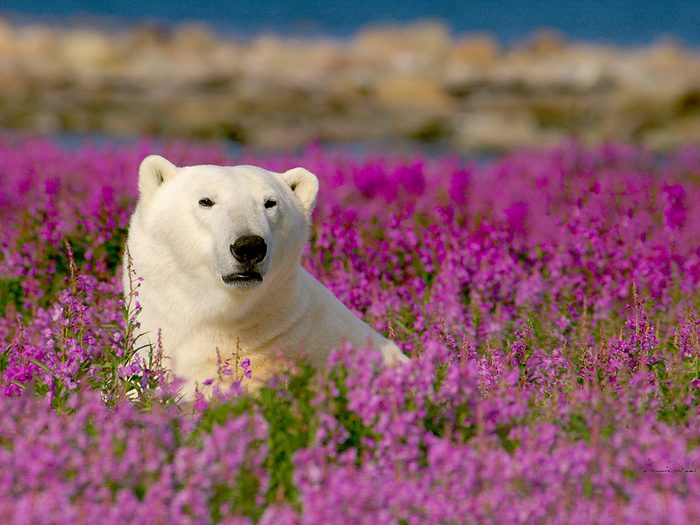
Newfoundland and Labrador
Puffins, whales and icebergs at Bay Bulls
The Atlantic puffin is an elusive, sweet-looking black-and-white bird with an orange beak and legs. Spending entire seasons on the cold, open waters of the North Atlantic, they return in May and stay for the summer to nest on sea cliffs in Quebec, Iceland and the Faroe Islands. You can find them by the thousands off the shores of Newfoundland’s Avalon Peninsula. From Bay Bulls, a small fishing village just south of St. John’s, cruise on a guided tour into the four islands that comprise the Witless Bay Ecological Reserve where, in the spring and summer, some 260,000 puffins come to nest. You’ll also find more than half a million storm petrels, birds that spend most of their lives swirling in the air, plus, some humpback whales and, in the spring, massive icebergs, majestic and white, headed south.
Discover the fascinating story of the Newfoundland pony— the province’s only designated heritage animal.

Nova Scotia
Wild horses at Sable Island National Park and Reserve
Sable Island National Park and Reserve is home to a constantly shifting, misty and mystical 45-kilometre crescent-shaped sandbar. Sitting about 175 kilometres off Nova Scotia’s mainland coast, explorers to the New World commonly spotted Sable’s sands and rightfully feared the surrounding currents—these waters are now home to some 350 shipwrecks. Today, visitors can safely visit the national park, however, and marvel at its most famous residents: 500 wild horses, descendants of those seized by the British during the Acadian expulsion in the 1700s. The horses have thrived on the sandbar by drinking from freshwater ponds, digging into groundwater with their hooves and eating beach grass. Encountering them is a strange and beautiful sight—perfect for a place like Sable.
Take a closer look at the horses of Sable Island.

Prince Edward Island
Plenty of playful foxes at Prince Edward Island National Park
Strung along the sea at Cavendish Beach, with its red cliffs and shifting dunes, Prince Edward Island National Park encapsulates all the best of this tiny province. The bird life is rich, and you can spot abundant marine mammals, including four types of seal, as well as porpoises, dolphins and both pilot and minke whales. But the highlight? Visitors will tell you: it’s the foxes. Red and black, with white-tipped tails, these cute little creatures are everywhere. They’re playful and unafraid of visitors, coming right up to you in search of food. And while it may be tempting to give them a treat, it’s best to just put your hands in your pockets and let them stay the wild creatures that they are.
Here are the 10 places in Canada every Canadian needs to visit.

New Brunswick
Rare whales off Grand Manan Island
In addition to boasting the world’s highest tides, the Bay of Fundy is home to all sorts of rare and spectacular wildlife. Visitors can take the ferry to Grand Manan Island, then explore the charming villages and landscape of plunging sea cliffs and rugged headlands. But the best part of the trek is whale-watching. You’ll find breaching humpbacks, plus minkes, finbacks, and the endangered northern right whale—only about 400 remain in the world. And if you don’t see a whale, you can still enjoy the abundant bird life, and maybe even spot a seal playing in the wake of the boat.
Discover more essential experiences on the east coast of Canada.

Quebec
Northern Gannets on Bonaventure Island
You’ll hear the northern gannets—thousands of them—before they come into view. Just a short ferry ride from the picturesque village of Percé (and its famous rock), Bonaventure Island is a provincial park with wild beaches, 15 kilometres of trails, and some 120,000 northern gannets, one of the largest colonies on earth. Just follow the Colony Trail, which winds through forest, fields and meadows, until you come to a clearing. There, the bird’s white wings obscure the island’s red soil like snowfall. Boat tours, which ply the waters below the cliffs, also depart from Percé, offering a different perspective on the almost-overwhelming number of birds here.
Here are more hidden gems in Quebec worth exploring.

Ontario
Spotting avian splendour at Point Pelee National Park
Canada’s most ecologically diverse national park is situated on the southernmost point of the Canadian mainland and covers a 14.5-kilometre peninsula. The beaches alone are worth the visit, sandy and warm, strung along Lake Erie. But the bird life? Completely spectacular. The park is one of the world’s top bird-watching sites and more than 390 winged species live or migrate through here, usually in the spring and fall. Explore the wetlands via a series of wooden boardwalks, and spot everything from scissor-tailed flycatchers to warblers, white-winged doves, nighthawks and whip-poor-wills—among others. Visit during the Festival of Birds, which is held in May, or in the fall, when the parks also hosts waves of monarch butterflies.
How many of these beautiful Canadian birds have you spotted on your travels?

Manitoba
Walking with polar bears in Churchill, Manitoba
Located on the shores of Hudson Bay, this small subarctic town is set directly on a main migration route for Canadian polar bears, making it the polar bear capital of the world. Drawn by the ice—it begins to form here in the fall—they arrive in a state of walking hibernation, eager to get hunting. While they often wander right downtown, perhaps the best (and safest) place to experience these bears is nearby, at Seal River Heritage Lodge, which sits right next to the bay. The entire lodge is ringed by fencing, allowing you to view curious bears from only a few inches away. And there’s nothing like the thrill of walking with them in the wild. Guides take guests out for twice-daily strolls on the tundra. You’ll get relatively close to these massive creatures, making it one of very few places where you can experience these bears, with no barrier, in a safe way.
Check out the most awe-inspiring natural wonders of Canada.

Saskatchewan
Wild bison at Prince Albert National Park
Prince Albert National Park is just a couple of hours north of Saskatoon and visiting here will make you feel like you’re in the Wild West. Here, you can ride a horse into the woods and sleep in a meadow under the open sky. This 3,874-square-kilometre park is also home to one of the only free-roaming herds of Plains Bison in North America. They’re the largest land mammals on the continent, weighing up to 860 kilos. Marvel at them from a safe distance, and keep your eyes peeled for other wildlife, including wolves, elk and moose.
These breathtaking photos of the Canadian prairies will have you packing your bags.

Alberta
Up-close with wolfdogs at Yamnuska Wolfdog Sanctuary, Rocky View County
Yamnuska is a sanctuary to 35 rescued wolfdogs—a hybrid of domestic dog and wolf—and gives visitors a rare opportunity to view these beautiful canines. Drive just north of Calgary and take the signature Sanctuary Walk, where guests can visit all of the enclosures along a scenic path, learning more about each animal and the species as a whole. And if you want to get even closer, sign up for an interactive tour, where guides will actually bring you inside as part of a small group to meet their ambassador dogs and hear them howl.
Discover more of the best hikes in Canada.

British Columbia
Finding grizzlies in Great Bear Rainforest
At the remote southern end of Great Bear Rainforest, the endless Pacific flows into the Queen Charlotte Strait, separating the north-eastern end of Vancouver Island and the B.C. mainland. Rolling out on those waters, Sea Wolf Adventures will take you across Nakwato Rapids—the fastest navigable tidal rapids on earth—and to places with names like God’s Pocket and Skull Cove. And along the way? You’ll be looking for bears. B.C. is home to about a quarter of the world’s grizzly population, many of which live in this corner of the province. Seeing one on shore, turning over crustaceans in the intertidal zone or fishing in a stream for salmon, is an experience you’ll never forget.
Check out 10 of the most breathtaking waterfalls in Canada.

Yukon
Caribou and “grolar” bears at Ivvavik National Park
Set upon the tundra and cradled into a set of velvety mountains, this park—one of Canada’s newest—sees only 200 visitors every year. Unconnected by road, you must organize a visit through Parks Canada and fly in on a Twin Otter supplied by a charter company, landing on a dirt strip that was once part of a mining camp. Once you arrive, you’re surrounded by natural wonders. Arctic char swim in the river and golden eagles fly overhead. While taking a ridgeline hike, the lucky will encounter anything from wolves to muskoxen to caribou, the latter of which migrate through the park by the hundreds of thousands. And while it sounds like a mythical creature, “grolars” roam the area—a hybrid of grizzlies and polar bears. Extremely rare and beautiful, they’re also fierce, so make sure to keep your distance.
Next, discover the best bird-watching destinations across Canada.